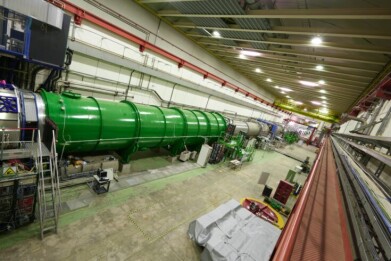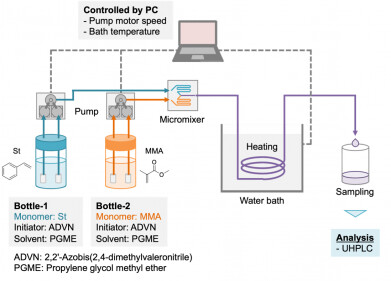-
 Experimental hall at CERN (Credit: CERN)
Experimental hall at CERN (Credit: CERN)
Research News
Ultra-rare decay observation projects physics beyond current standard
Oct 01 2024
An ultra-rare particle decay process that will open a new path to find physics beyond our understanding of how the building blocks of matter interact, has been discovered by scientists at CERN.
The NA62 collaboration, involved in an experiment designed and constructed specifically to measure the kaon decay process, has announced the first experimental observation of the charged kaon into a charged pion and a neutrino-antineutrino pair, making it the rarest decay ever established experimentally at the 5 sigma level. The Standard Model of particle physics predicts that less than one in 10 billion kaons will decay in this way.
Researchers from the universities of Birmingham, Bristol, Glasgow and Lancaster have made a significant contribution to the experiment. The new result is based on data from 2016-2018 combined with data taken in 2021 and 2022, following upgrades enabling operation at 30% higher beam intensity, along with new detectors that collected signal candidates at a 50% higher rate than before.
Dr Karim Massri, the NA62 Physics Coordinator from Lancaster University welcomed the announcement: “Finding hints of new physics still requires more data, but this result is a leap forward and further strengthens an already strong interest in the future results from NA62”.
Professor Cristina Lazzeroni at the University of Birmingham said: “During my mandate as NA62 Spokesperson in 2019–2022, I secured the prolongation of NA62 beyond 2018 and I led the detector upgrade. On the back of that extension of the experiment, I am extremely proud of the new result.”
Professor Evgueni Goudzovski from the University of Birmingham and the current leader of the NA62-UK consortium commented: “The UK group has led the physics exploitation of the NA62 experiment over the past decade, providing leadership at all levels including senior spokesperson and physics coordinator roles.
“Attracting top talent and providing opportunities and mentorship for early-career researchers has been our priority. It is a privilege to work in and lead such an energetic and constructive team.”
Professor David Britton, team leader of the Glasgow NA62 group and Project Leader of the GridPP Project that delivers key computing infrastructure support for the project said: “This amazing achievement of observing such an extraordinarily rare decay has relied critically on the long-term support of the GridPP computing infrastructure in the UK by STFC. That infrastructure, led by researchers at the University of Glasgow, has enabled the generation of the billions of simulated events over the last decade that were used to understand the detector, the backgrounds and the expected signature in the data. This work enabled and under-pins the physics result announced today.”
More information online
Digital Edition
Lab Asia 31.6 Dec 2024
December 2024
Chromatography Articles - Sustainable chromatography: Embracing software for greener methods Mass Spectrometry & Spectroscopy Articles - Solving industry challenges for phosphorus containi...
View all digital editions
Events
Jan 22 2025 Tokyo, Japan
Jan 22 2025 Birmingham, UK
Jan 25 2025 San Diego, CA, USA
Jan 27 2025 Dubai, UAE
Jan 29 2025 Tokyo, Japan



.jpg)














